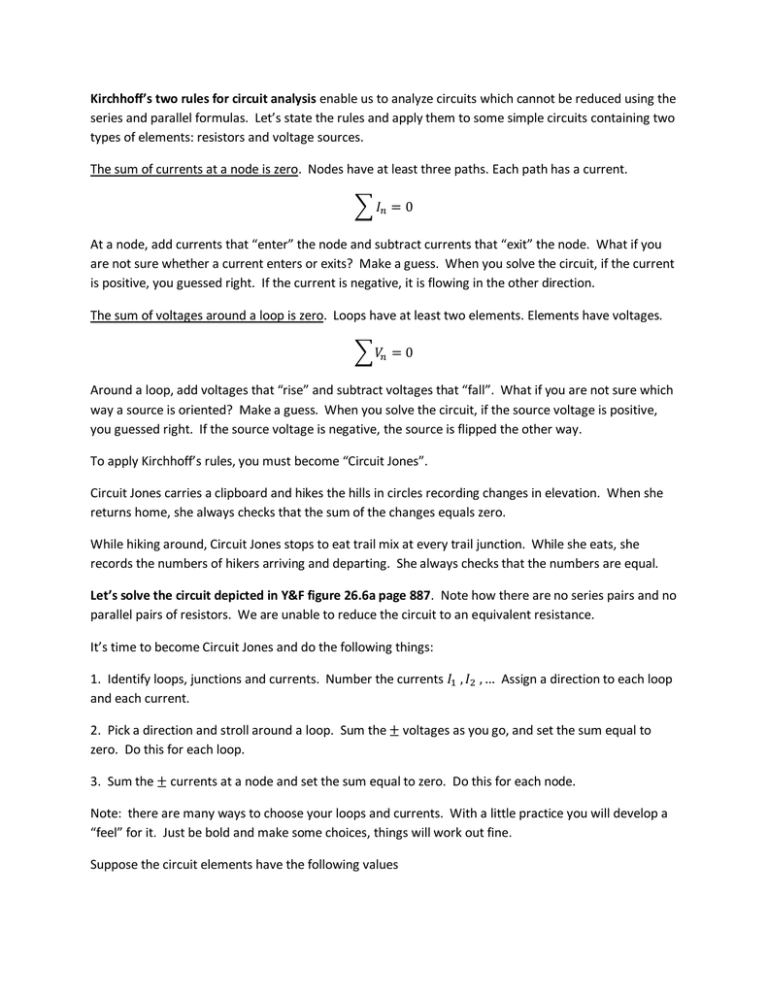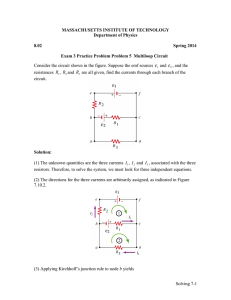Kirchhoff`s two rules for circuit analysis enable us to analyze circuits
advertisement

Kirchhoff’s two rules for circuit analysis enable us to analyze circuits which cannot be reduced using the series and parallel formulas. Let’s state the rules and apply them to some simple circuits containing two types of elements: resistors and voltage sources. The sum of currents at a node is zero. Nodes have at least three paths. Each path has a current. ∑ At a node, add currents that “enter” the node and subtract currents that “exit” the node. What if you are not sure whether a current enters or exits? Make a guess. When you solve the circuit, if the current is positive, you guessed right. If the current is negative, it is flowing in the other direction. The sum of voltages around a loop is zero. Loops have at least two elements. Elements have voltages. ∑ Around a loop, add voltages that “rise” and subtract voltages that “fall”. What if you are not sure which way a source is oriented? Make a guess. When you solve the circuit, if the source voltage is positive, you guessed right. If the source voltage is negative, the source is flipped the other way. To apply Kirchhoff’s rules, you must become “Circuit Jones”. Circuit Jones carries a clipboard and hikes the hills in circles recording changes in elevation. When she returns home, she always checks that the sum of the changes equals zero. While hiking around, Circuit Jones stops to eat trail mix at every trail junction. While she eats, she records the numbers of hikers arriving and departing. She always checks that the numbers are equal. Let’s solve the circuit depicted in Y&F figure 26.6a page 887. Note how there are no series pairs and no parallel pairs of resistors. We are unable to reduce the circuit to an equivalent resistance. It’s time to become Circuit Jones and do the following things: 1. Identify loops, junctions and currents. Number the currents and each current. 2. Pick a direction and stroll around a loop. Sum the zero. Do this for each loop. 3. Sum the Assign a direction to each loop voltages as you go, and set the sum equal to currents at a node and set the sum equal to zero. Do this for each node. Note: there are many ways to choose your loops and currents. With a little practice you will develop a “feel” for it. Just be bold and make some choices, things will work out fine. Suppose the circuit elements have the following values Label the three unknown resistor currents and , the first two pointing upward, the second pointing downward. To solve for these unknown quantities we need three equations. Let’s use the loops depicted in the figure. Summing voltages around the loops, and currents into the junctions We need not sum currents at the lower node; it gives us the same equation as the upper node. Keep an eye out for redundant equations, they pop up often. Notice that we already have three independent equations in the three unknowns. How do you know when a voltage change is positive or negative? As you walk around a loop, pay attention to the direction of each resistor current and ask yourself “does the current flow with me or against me?” If with you, the voltage change is negative. If against you, the voltage change is positive. Also, as you walk across a voltage source, if you go from the low side to high side, the voltage change is positive, otherwise it is negative. Now we have an algebra exercise. Since the numeric values are simple, Insert the numeric values, then eliminate and to leave one equation in [ ] Solve for the value of , then use it to find the other currents We are done. As a check, calculate the voltages and verify that the loop voltage sums are zero (just insert the currents into the two loop equations). Everything checks out! How did we know which current directions to use? We guessed based on the emfs. Our guesses could be wrong, but that’s ok. What if we had defined all of our currents to be pointing upward? Then There is nothing flowing out! What does this mean? It means at least one of the currents is negative. What if one of the emfs is unknown? Then we have four unknowns. Can we write a fourth equation? No, there are only two independent loops in the circuit, and one independent node, which gives three equations. As stated, the problem is insoluble. Suppose we know the first current . Excellent! Now we can solve the problem. Let But wait! Before we knock ourselves out with a lot of work, let’s be smart: let’s see what we can do with a known current. It turns out that we can solve for one unknown at a time. Look at : we know its resistance and current. Aha! Using Ohm’s law , we can find its voltage What does this do for us? Look at the outer loop. As we hike the outer loop, there is only one unknown voltage, . Using the outer loop voltage sum we can find Now that we know two of the three currents at the upper junction, we can find the third Did you notice that is negative? This means the current is actually Finally, the unknown emf flowing the other direction. is found from either of the inner loop sums. Taking the right loop Done! Rather than solving three equations in three unknowns, we solved for the unknowns one at a time. Look for these opportunities to make your life a lot easier. Application of Kirchoff’s loop rule to the With switch connected to battery circuit , and with current into capacitor, sum voltages Substitute for the current as indicated to obtain ∫ ∫ The solution is ( ) [ ( )] With switch connected to ground, sum voltages around the loop to obtain Substitute for the current as indicated to obtain ∫ The solution is ( ) ( ) ∫


